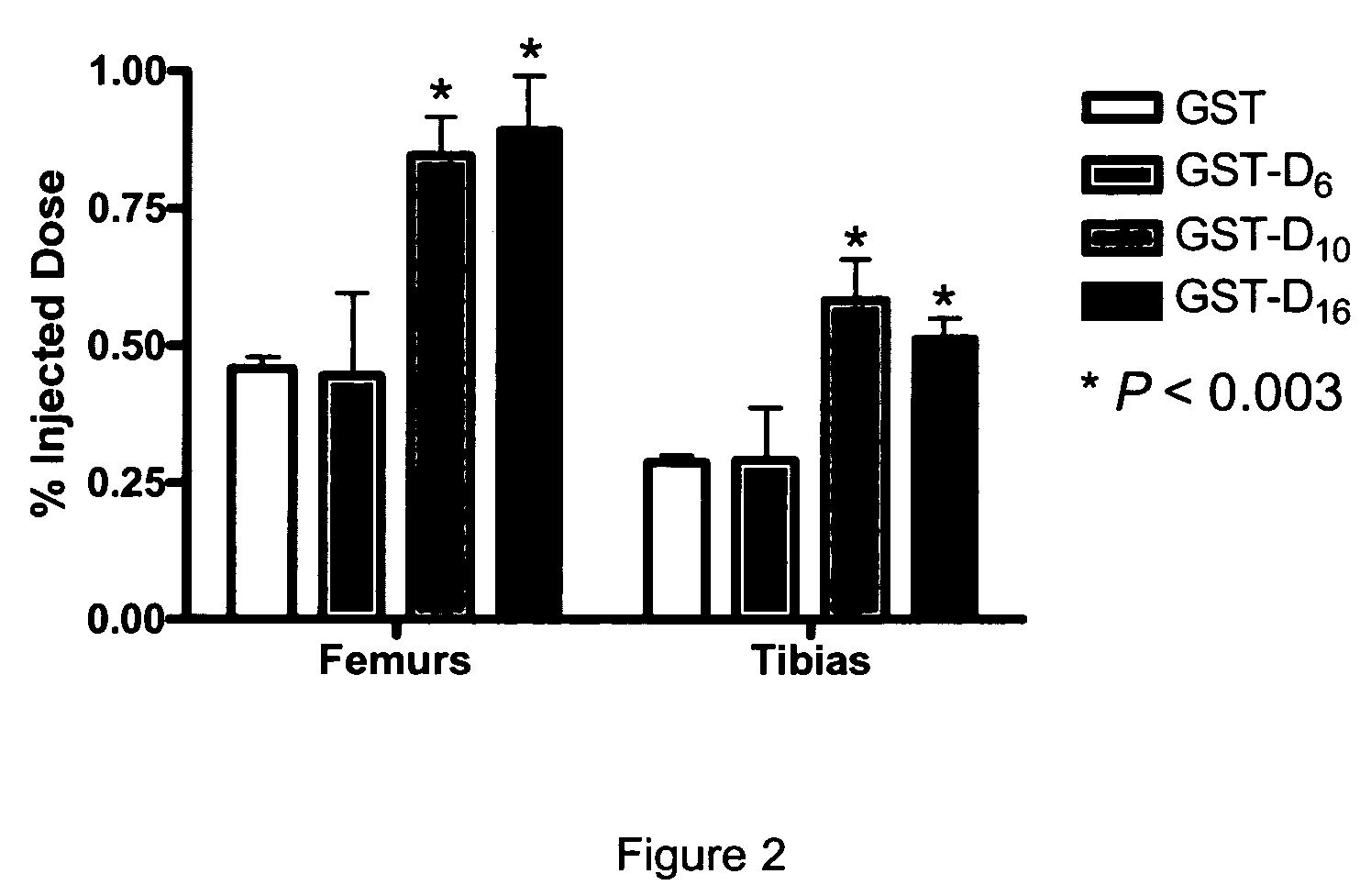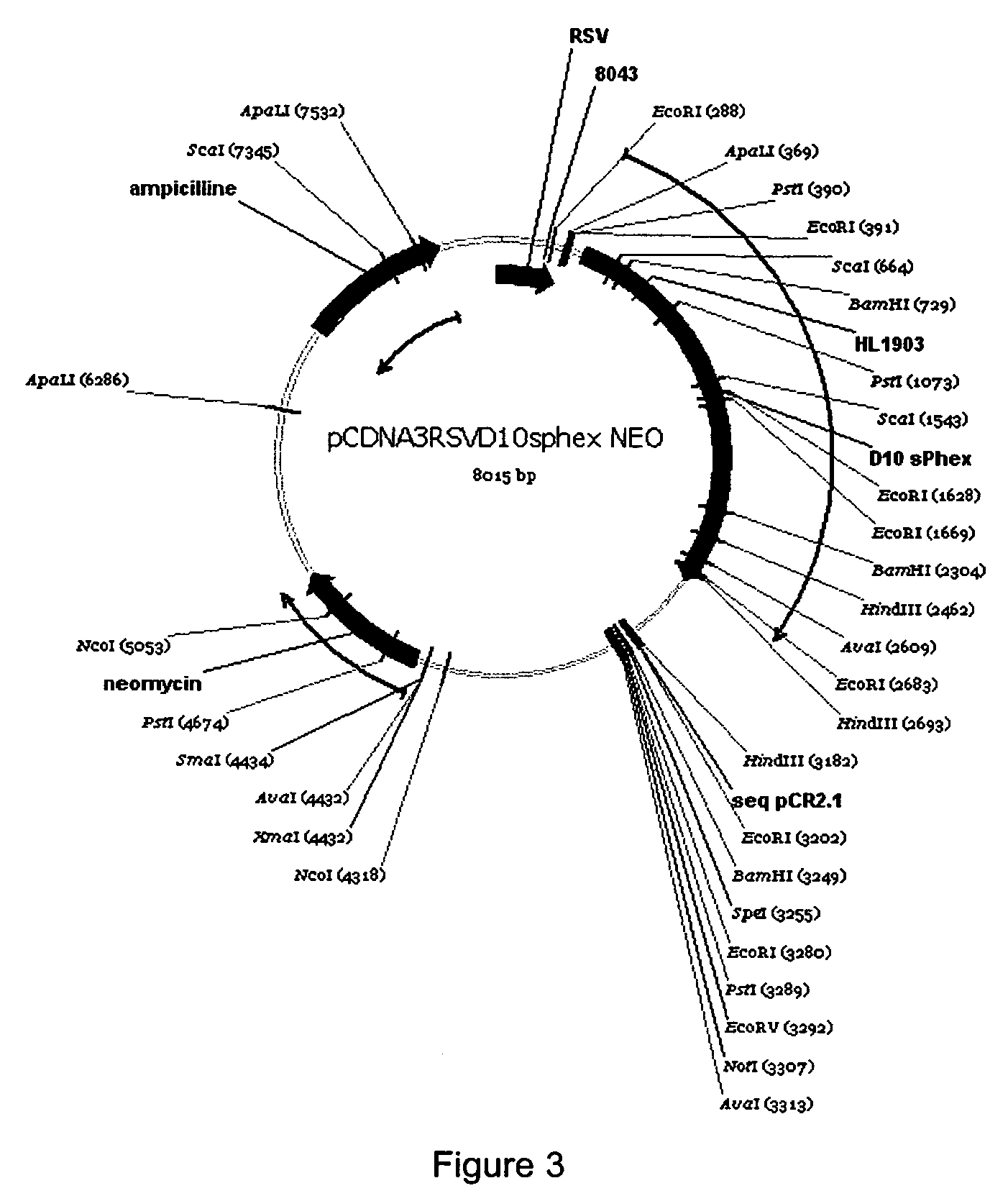Bone delivery conjugates and method of using same to target proteins to bone
a technology of conjugates and proteins, applied in the field of bone delivery conjugates and methods of using same to target proteins to bone, can solve the problems of poor healing of painful recurrent stress fractures, rickets or osteomalacia, and not all attempts to treat genetic disorders through ert have been successful
- Summary
- Abstract
- Description
- Claims
- Application Information
AI Technical Summary
Benefits of technology
Problems solved by technology
Method used
Image
Examples
example 1
Bone Binding of GST-D6, GST-D10 and GST-D16
[0085]Recombinant DNA technology was used to generate a plasmid containing a nucleic acid encoding GST followed in frame by a nucleic acid encoding a D6, D10 or D16 acidic peptide. To obtain the GST-D6, GST-D10 and GST-D16 conjugates, the oligonucleotide of SEQ ID NO:9 (see Table 1) was first mixed with the oligonucleotide of SEQ ID NO:10, oligonucleotide of SEQ ID NO:11 mixed with oligonucleotide of SEQ ID NO:12, and oligonucleotide of SEQ ID NO:13 mixed with oligonucleotide of SEQ ID NO:14. This procedure generated duplex oligonucleotides coding for D6, D10 and D16, respectively, and having extremities compatible with cloning in the pGEX3T-4 plasmid (Pharmacia biotechnology) pre-digested with restriction endonucleases BamHI and NotI. pGEX3T-4 vectors were transformed into AP401 protease minus E. coli bacteria strain (Ion::mini tetR ara-Δlac-pro nalA argEam rifR thiI [F′ pro AB lacIq Z M15]).
[0086]Positive bacterial colonies were used to ...
example 2
Binding Ability of GST Fused with Various Peptides
[0092]Human matrix extracellular phosphoglycoprotein (hMEPE) is a protein synthesized by osteoblasts that shows major similarities to a group of bone and teeth mineral matrix phosphor-glycoproteins, proteins known to naturally bind to bone matrix (8). Of particular importance, hMEPE presents at its carboxy-terminus a sequence of 18 amino acid residues (DDSSESSDSGSSSESDGD) (SEQ ID NO: 31) similar to acidic peptides found in dentin phosphorin and dentin sialophosphoprotein, both known to bind to bone matrix (8).
[0093]Human Statherin (hStatherin) is a protein synthesized by salivary glands, which similarly to histatin directly modulates hydroxyapatite nucleation and / or growth. Of particular importance, hStatherin presents a sequence of 15 amino acid residues at positions 20 to 34 (DSSEEKFLRRIGRFG) (SEQ ID NO: 32) that was shown to bind tightly to hydroxyapatite (9).
[0094]Human Matrix Gla Protein (hMGP) is a protein synthesized by vascul...
example 3
D10 Increases sPHEX's Ability to Correct Alkaline Phosphatase Levels in Mice
[0105]PHEX is a metallopeptidase that is widely believed to control the level of bone peptide factors involved in the regulation of mineralization and kidney phosphate homeostasis. PHEX is expressed at the surface of osteoblasts and osteocytes in contact with or imbedded in the bone matrix. This example provides data on the design, production and purification of an extended form of sPHEX containing at its N-terminus a sequence of 10 aspartic acid residues designed to anchor itself to the bone matrix.
D10sPHEX Expression Vector
[0106]A BspEl endonuclease restriction site was inserted by site directed mutagenesis (QuickChange, Stratagene) into the pCDNA3-RSV-sPHEX-NEO vector (Boileau G. et al., Biochem. J. (2001) 355, 707-13) using the following oligonucleotide primers:
[0107]
(SEQ ID NO:38)5′-CAGTCAAGGTCTCTTATCCGGAAGTCTCCAAGCTAAACAGG-3′and(SEQ ID NO:39)5′-CTGTTTAGCTTGGAGACTTCCGGATAAGAGACCTTGACTGG-3′
[0108]The hexa...
PUM
| Property | Measurement | Unit |
|---|---|---|
| body weight | aaaaa | aaaaa |
| body weight | aaaaa | aaaaa |
| body weight | aaaaa | aaaaa |
Abstract
Description
Claims
Application Information
 Login to View More
Login to View More - R&D
- Intellectual Property
- Life Sciences
- Materials
- Tech Scout
- Unparalleled Data Quality
- Higher Quality Content
- 60% Fewer Hallucinations
Browse by: Latest US Patents, China's latest patents, Technical Efficacy Thesaurus, Application Domain, Technology Topic, Popular Technical Reports.
© 2025 PatSnap. All rights reserved.Legal|Privacy policy|Modern Slavery Act Transparency Statement|Sitemap|About US| Contact US: help@patsnap.com



